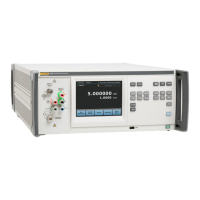Remote Commands
Input Buffer Operation 6
6-3
Incoming Character Processing
The Product processes all incoming data (except Binary Block Data as described
under the *PUD commands.):
• The most significant data bit (DIO8) is ignored.
• All data is taken as 7-bit ASCII.
• Lower-case or upper-case characters are accepted.
• ASCII characters whose decimal equivalent is less than 32 (Space) are
discarded, except for characters 10 (LF) and 13 (CR) and in the *PUD
command argument. *PUD allows all characters in its argument and
terminates in a special way.
Response Message Syntax
The command descriptions in this chapter, describe responses from the Product
wherever appropriate. In order to know whether to read in an integer, a floating-
point number, or character string, the first entry is (Integer), (Floating), or (String).
The response is identified as one of the data types in Table 6-2.
Note
The responses described in the command descriptions are correct
for IEEE-488 remote control, and for serial/Ethernet/USB remote
control in COMPUTER mode. TERMINAL mode responses (in
serial/Ethernet/USB remote control) contain more descriptive text
intended for an operator using a terminal interactively.
Input Buffer Operation
As the Product receives each data byte from the controller, it places the bytes in
a portion of memory called the input buffer. The input buffer holds up to 128 data
bytes and operates in a first in, first out fashion.
The Product treats the EOI IEEE-488 control line as a separate data byte and
inserts it into the input buffer if it is encountered as part of a message terminator.
Input buffer operation is transparent to the program running on the controller. If
the controller sends commands faster than the Product can process them, the
input buffer fills to capacity. When the input buffer is full, the Product holds off the
IEEE-488 bus with the NRFD (Not Ready For Data) handshake line. When the
Product has processed a data byte from the full input buffer, it then completes
the handshake, allowing the controller to send another data byte.
The Product clears the input buffer on power-up and on receiving the DCL
(Device Clear) or SDC (Selected Device Clear) messages from the controller.
Under RS-232-C serial port remote control using Control/S (XOFF) protocol, the
Product issues a Control/S (XOFF) when the input buffer becomes 80% full. The
Product issues a Control/Q (XON) when it has read enough of the input buffer so
that it is less than 40% full. When RTS (Request to Send) protocol is used, the
serial interface retracts and asserts RTS in response to same conditions as for
XON/XOFF protocol.

